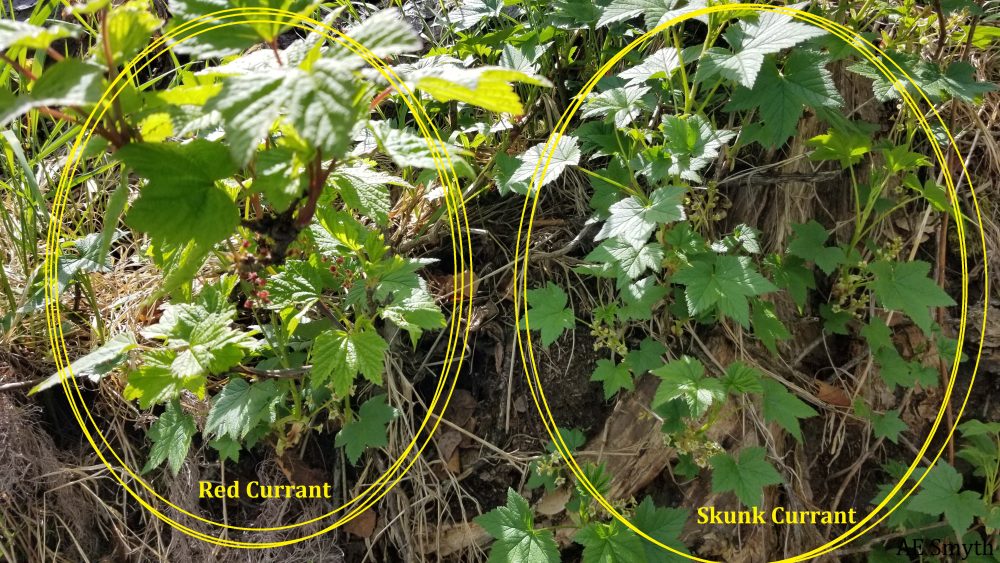Climate Data
First and Last Freeze dates collected directly from the NWS Climate Information webpage. Areas I’ve searched are Utqiaġvik, Kotzebue, Fairbanks, Bethel, Talkeetna, Anchorage, Homer, and Juneau, but many more areas are searchable.
Similar Fellows
Here is a comparison of blueberry species growing near each other in subalpine areas. Left image is Early Blueberry with Alaska Blueberry in August (Alyeska). Right image is Dwarf Blueberry with Bog Blueberry in September (Hatcher Pass).
Red Currant and Skunk Currant flowering together in a swamp area in May (Big Lake).


Some terms directly copied from the glossary of WETLAND SEDGES of ALASKA
WETLAND SEDGES of ALASKA (2003)
Gerald Tande & Robert Lipkin,
Alaska Natural Heritage Program, Environment and Natural Resources Institute, UAA.
Bog– Peat-covered wetland where vegetation shows the effects of a high water table and a general lack of nutrients. Bogs receive their nutrients only from rain water; vegetation is not nourished by mineral-enriched groundwater. Calcium (Ca) and magnesium (Mg) levels in the groundwater are extremely low. Bog surfaces are virtually isolated from mineralized soil waters. The surface waters are strongly acidic (pH generally less than 4.6) and the upper peat layers are extremely low in nutrients. Cushion-forming Sphagnum mosses and heath shrubs are common. Trees may be present or absent; if present, they generally form open-canopied stands of low, stunted trees. Peat is primary formed by Sphagnum mosses.
Fen– Peatland characterized by a high water table, but with very slow internal drainage by seepage down very gradual slopes. Slow-moving groundwater is enriched by nutrients (particularly Ca and Mg) from upslope materials; fens are thus more mineral-rich than bogs. The pH of the groundwater is generally 5.5 – 7.0. Vegetation reflects quality and quantity of available water, resulting in three basic fen types: graminoid (usually sedge) fens, shrub fens, and treed fens. Sedges and “brown mosses” are the primary peat formers in fens.
Marsh– Wetland that is periodically inundated by standing or slow-moving water, and hence rich in nutrients. Mainly wet, mineral soil areas characterized by emergent vegetation of reeds, rushes, sedges or grasses. Peat formation is often minimal. They are subject to water drawdown, but water remains within the rooting zone for most of the growing season. Waters are usually almost neutral to slightly alkaline. Surface water levels may fluctuate seasonally, and vegetation often has distinct zones reflecting water depth, frequency of drawdowns, and/or salinity.
Muskeg– Colloquial and old term used to refer to the complex mosaic of fens, bogs, swamps, pools and scrubby forest that becomes increasingly common to the north. In interior Alaska and Canada, the term is used to describe a black spruce and Sphagnum peatland. It is also a common term for southeast Alaskan wetlands characterized by stunted, gnarled trees (many with bonsai-like forms), pit ponds and larger pools (containing skunk cabbage, yellow pond-lily, and various pondweeds) drained by rills and small streams snaking between thick lawns of Sphagnum moss and islands of stunted forest and shrubs. In this cool, humid, oceanic climate, they may cover depressional areas as well as slopes of considerable steepness.
Peatlands– Generic term including all types of peat-covered terrain. Areas of accumulation of more than 40 cm of peat above the mineral soil. The 40 cm depth is the thickness of rooting for the majority of wetland plants.
Swamp– Wetland where standing or gently moving waters occur seasonally or persist for long periods, leaving the subsurface continuously waterlogged. Water table may drop seasonally, creating aerated conditions in the rooting zone of vegetation. Swamp waters are almost neutral to moderately acid, and show little deficiency in oxygen or mineral nutrients. They are nutritionally intermediate between bogs and fens. Substrates consist of mixtures of mineral and organic materials, or woody, well-decomposed peat. Vegetation may be dense coniferous or deciduous forest, or tall shrub thickets. Most peat-forming mosses are absent, or present only in a subordinate role. Woody species are the primary peat formers in swamps, and in many swamps, peat formation is minimal.
Unique Berries
Interesting color variations or odd looking berries growing among their typical fellows. Left image is a trailing raspberry growing with the usual red ones. Middle image is a bog blueberry with exactly half the berry ripened. Right image is the newly discovered ‘woodfrogberry’!













